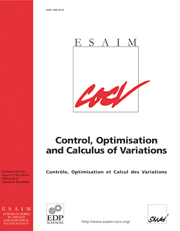Article contents
Computation of the demagnetizing potential in micromagnetics using a coupled finite and infinite elements method
Published online by Cambridge University Press: 15 August 2002
Abstract
This paper is devoted to the practical computation of the magnetic potential induced by a distribution of magnetization in the theory of micromagnetics. The problem turns out to be a coupling of an interior and an exterior problem. The aim of this work is to describe a complete method that mixes the approaches of Ying [12] and Goldstein [6] which consists in constructing a mesh for the exterior domain composed of homothetic layers. It has the advantage of being well suited for catching the decay of the solution at infinity and giving a rigidity matrix that can be very efficiently stored. All aspects are described here, from the practical construction of the mesh, the storage of the matrix, the error estimation of the method, the boundary conditions and a simple preconditionning technique. At the end of the paper, a typical computation of a uniformly magnetized ball is done and compared to the analytic solution. This method gives a natural alternatives to boundary elements methods for 3D computations.
- Type
- Research Article
- Information
- Copyright
- © EDP Sciences, SMAI, 2001
References
- 6
- Cited by


